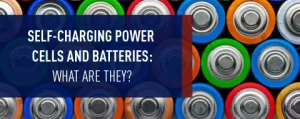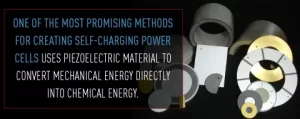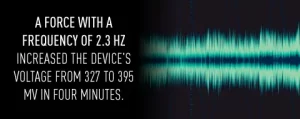Jump To: What Is Energy Harvesting | Types of Self-Charging Power Cells | Piezoelectricity in Energy Harvesting | Piezo Materials Role | Lithium-Ion Batteries | Looking Ahead

We typically think of energy generation and energy storage as two different processes requiring two separate devices, but recent advances have revealed that we can, in fact, do both with just one device. Research into self-charging power cells and batteries continues to accelerate as the cells become more efficient and the power consumption demands of electronics decrease.
These self-charging power cells work by converting mechanical energy, the energy related to an object’s motion and position, into chemical energy. The technologies can release the converted energy as an electric current that can power other devices. Self-charging batteries may be able to increase the efficiency of our energy use, decrease the weight and size of our electronic devices and maybe even make dead batteries a thing of the past.
Critical to self-charging power cell technology is the concept of energy harvesting, which is the collection of “free” energy that a process generated.
This includes all sorts of processes, and the resulting energy could come in a variety of forms and from various sources. This power could come from inefficiencies in more conventional forms of power generation, for example. In 2013, we lost approximately 65 percent of the energy generated by natural gas, coal, nuclear and petroleum facilities. Six percent gets wasted during transmission and distribution.
We can also harvest energy from environmental sources, such as the sun and the wind. Smaller scale examples include heat from furnaces and mechanical energy created by walking or driving. Much of the work with energy harvesting has so far been done with smaller scale applications, such as batteries for small devices. When you use your smartphone, for instance, some of the energy gets wasted in the form of heat.

Energy harvesting, also known as energy scavenging, allows us to capture this energy, convert it to a usable form and direct it to a useful application.
Natural and industrial processes like this have always created excess energy, but it occurred in small doses that we were not able to capture and put to use in the past. Because the energy typically occurs in small amounts, the technology used to capture it needs to be extremely efficient to get enough power to be useful. It also needs to store the energy for long enough so it’s available when needed.
Additionally, the energy needs to be converted correctly for the intended use but still be able to tolerate irregular input. It can be difficult to know exactly how much charge will be created. These irregularities have also made energy harvesting technologies a rather unreliable way to generate energy. Users could not depend on it, and this limited its use.
Because the input is irregular, the energy-capturing device must be ready to generate power and provide an output of power whenever the user needs it to. Staying active in this way cannot take up too much energy because the energy comes in small doses, and that energy will be necessary to perform the desired function.
In short, a self-charging power cell must be able to generate, store and manage energy highly efficiently to work well enough to serve a useful function.
Several different technologies for generating and storing energy within a single unit have emerged in recent years.
They each are best suited to different kinds of devices and have unique challenges and benefits. Three prominent types are radio frequency, solar and piezoelectric power cells.
1. Radio Frequency
A startup called Nikola Labs has developed a smartphone case that plugs into the bottom of the phone and charges it by converting radio waves the phone receives from cell towers and wireless routers into energy the device can use to operate. Nikola says its charger can extend a smartphone’s battery life by 25 to 30 percent. It works because it’s located so close to the phone’s radio transmitter and captures waves that the phone doesn’t need for communication.
2. Solar
Researchers are also getting closer to creating a self-charging battery powered by light. Researchers at McGill University, in partnership with Hydro-Québec, incorporated photo-harvesting dye molecules into a lithium-ion battery cathode, which allowed the battery to use light to charge. The project is now moving into the second stage, which involves creating the storage portion of the cell. If they can succeed in creating a small, operational anode to store the solar energy, we could use it to charge smartphones and other small devices.
3. Piezoelectric
One of the most promising methods for creating self-charging power cells uses piezoelectric material to convert mechanical energy directly into chemical energy. Researchers from the Georgia Institute of Technology recently published a study on a device that does just that.
The project began with a coin-type Li-ion battery. The researchers replaced the polyethylene separator between the two electrodes within the battery with a polyvinylidene difluoride, or PVDF, film. Because of its piezoelectric properties, when the PVDF is under applied stress, it generates a charge that causes Li-ions to move from the cathode to the anode, charging the battery.

In the experiments, attaching the device to a shoe and walking provide enough force to charge it. A force with a frequency of 2.3 Hz increased the device’s voltage from 327 to 395 mV in four minutes. This represents a 65 mV increase in voltage as compared to a power cell with the conventional polyethylene layer separating the Li-ion battery and the PVDF piezoelectric generator. The process of converting mechanical energy to chemical energy proved to be significantly more efficient than converting mechanical energy to electrical energy and then into chemical energy storage, which is the process used in a traditional battery.
Once the ions reach an equilibrium, the charging stops. After the applied stress ceases, a new compound forms with the anode material that allows that energy to be stored. This allows you to control when you release the energy, which utilizes, like in traditional batteries, electrochemical reduction-oxidation reactions to produce a current of around one microampere (μA).
These findings would mostly apply to small devices, such as smartphones. The researchers also showed that their device could charge at higher voltages as well, so it may have more possible applications in the future. Piezoelectric electronics can only generate a small amount of charge at any given time, which means that energy must be built up and stored before use. This present challenges for using the technology on a large scale. Further research and development may make this more feasible.
At APC International, we supply piezo products such as piezoelectric ceramics, piezoelectric transducers, piezo devices as well as piezo application support services. We have provided some piezoelectric ceramics for use in energy harvesting. For these applications, we recommend APC 850, a ceramic element manufactured from lead zirconate titanate (PZT).
Piezoelectric power has been used in a variety of prototypes, proof-of-concept projects and small-scale applications related to energy harvesting. This technology is still young, but it offers some exciting prospects for the future. How, though, do these materials generate energy?
First discovered in 1880, the piezoelectric effect describes a characteristic of some crystalline minerals that causes them to become electrically polarized when mechanical force is applied to them. When these materials are subjected to tension and compression, they generate voltages in proportion to the force and of opposite polarity. Mechanical force on a poled piezoelectric ceramic element creates a voltage by changing the dipole moment, the measure of net molecular polarity, of the element.

The inverse of this effect is also true. When the crystals come into contact with an electric field, they lengthen or shorten according to the field’s strength and polarity.
The piezoelectric effect creates generator actions, while its inverse creates motor actions. The piezoelectric effect transforms mechanical energy to electrical and can be used in solid-state batteries, fuel-igniting devices, force-sensing devices and other applications. The inverse piezoelectric effect changes electrical energy to mechanical energy and can be used in piezoelectric motors, sound or ultrasound generating devices and other instruments.
The voltages and forces of the piezoelectric effect are relatively small, but they can still be used for a wide range of applications, such as displacement sensing, actuation applications in motors that require precise positioning control and producing sonic signals.
Most piezoelectric devices designed for energy harvesting use two layers of piezoelectric material attached to a non-piezoelectric layer, known as a bimorph, with a cantilever geometry architecture. Some also use a unimorph, which consists of just one layer, although this produces half as much energy with a relatively small decrease in volume.
Sometimes, off-resonance energy harvesters might be used as an alternative architecture for energy harvesters. These architectures include piezoelectric stacks and cymbal transducers, which have a high stiffness and a natural frequency of over one kHz, which is more than most natural vibration.
They also have low sensitivity to applied stress, which limits their potential to collect energy from low-amplitude ambient vibrations. They can, however, tolerate a larger mechanical load than cantilever harvesters, which makes them able to achieve a higher energy output.
You can apply piezoelectric energy harvesting at scales that range from piezoelectric floors multiple square meters in size to sub-micron nanowire arrays. These harvesters can be categorized according to their size as:
Devices that require manual assembly and bonding can be classified as macro- and mesoscale. Devices made using standard photolithography techniques are considered MEMS scale. Devices that use piezoelectric nanowires are nanoscale energy harvesters.
Metal oxide-based piezoelectric ceramics are human-made materials that allow the piezoelectric effect to be applied to many different applications. We can adjust the shape, dimensions and composition of these materials to better fit the needs of individual projects.
A conventional piezoelectric ceramic is a group of perovskite ceramic crystals that consists of a small tetravalent metal ion, typically zirconium or titanium, within a lattice of larger divalent metal ions, typically barium or lead, and O2 ions.
PZT, or lead zirconate titanate, is currently one of the most commonly used piezoelectric ceramic elements. We offer five proprietary piezo materials — APC 880, APC 855, APC 850, APC 841 and APC 840.
The voltage provided by both lithium-ion batteries and self-charging piezoelectric batteries can vary from cell to cell, but lithium ions provide a stronger current than today’s piezoelectric designs across the board. A typically nominal cell voltage for a lithium-ion battery might be around 3.6 volts. The piezoelectric self-charging battery is still a young technology, meaning they will likely become more efficient in the future.
Of course, the major advantage of using a self-charging piezoelectric cell over a conventional lithium-ion battery is that you don’t need a DC source to charge it. All you need is mechanical force, which means you could charge these batteries anywhere. Even though they provide relatively small amounts of power, they beat lithium-ion batteries in situations where no conventional charging source is available.
The future of the self-charging piezoelectric battery is promising. We will continue to see advancements in performance and efficiency as well as the introduction of new applications.
The Georgia Institute of Technology researchers have predicted that they can improve their cell’s performance with several modifications, including using a more flexible casing so that the piezoelectric material can expand further. We will also likely see improvements that allow for a greater charge to be generated and stored and more effective energy management methods. Other self-charging technologies will also likely both emerge and continue to improve, and combining them with piezoelectric substances could yield useful results.
Currently, piezoelectric power cells mostly exist as prototypes or proof-of-concept devices that power small devices such as smartphones. In the relatively near future, we may begin to see them make their way into the hands of consumers. We may also see the military or police forces start to use them to keep their equipment charged as they move around while on duty.
Eventually, we may be able to use piezoelectric batteries on a large scale and to meet more demanding power needs. We can imagine using it to capture the mechanical energy created by cars driving on the road and using that energy to help power those vehicles or to power nearby buildings. It has the potential to aid us in cutting down on the amount of energy we lose due to heat and other causes of energy waste.
At APC international, we supply piezo products and services required for energy harvesting applications as well as for many other uses. As mentioned earlier, we suggest our APC 850 PZT element for use in energy harvesting.
Energy collection isn’t the only thing our customers use our piezo products for. In fact, it’s a relatively rare application because the technology is so new. We offer a wide variety of piezo elements, products and services including piezo discs, rings, plates and cylinders, stack actuators, amplifiers, igniters and much more. We also offer custom piezoelectric solutions and information resources such as our over-100-page textbook on the principles and applications of piezoelectric ceramics.
Please browse our selection of products and services to find the perfect piezo solution for your project requirements and feel free to contact us with any questions.
Piezoelectric Effect vs. Piezoresistive Effect
History and Development of Ultrasound Technology
Medical Applications of Ultrasonic Transducers
Piezoelectricity & Wearable Technology
Technology Generates Functional Benefits
